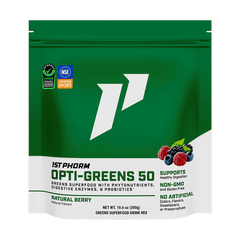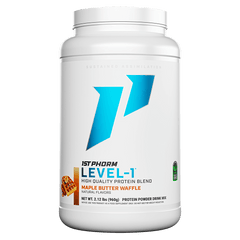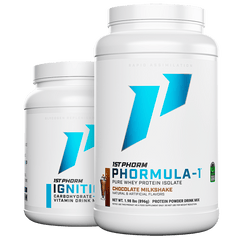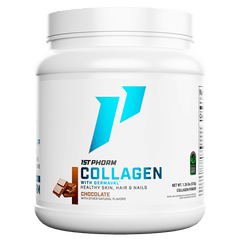What Are Deadlifts?
The deadlift is often referred to as the king of all exercises, and for good reason. Deadlifts are one of the biggest bang-for-the-buck exercises in the books. They work your entire body, and you can load them super heavy!
As a result, they’re great for building strength, packing on muscle, and burning a lot of calories. In a way, they really are almost a one-stop-shop lift.
The deadlift isn’t just for bodybuilders and hardcore gym-goers either. Deadlifts are a great way to improve your posture, leg strength, and grip strength all in one.
Having a strong deadlift benefits you and your everyday life in a major way. But, what are all the specific benefits of deadlifting? Keep reading and you’ll find out everything you need to know.
What is a Deadlift?
A traditional deadlift is when you step up to a loaded barbell, grab it with both hands, and pick it up. Clearly, that’s quite a bit oversimplified, but that is precisely what a deadlift is!
With a deeper look, you'll see that deadlifts require strength and coordination throughout your entire body.
This makes the deadlift one of the single greatest tests of strength and power. To go into more detail … you first need to set up for a deadlift by putting a loaded barbell on the floor in front of you.
Walk up to the barbell until the bar is touching your shins. Place your feet forward and roughly shoulder-width apart. Hinge forward at your hips to grab the bar outside of your knees while keeping your head, neck, and back straight. Bring your knees over the bar slightly and pull yourself into a shallow squat.
Breathe in deep, brace your core, and pull your shoulders down and back. Now, push through your feet while pulling the weight off the ground, sending your hips forward.
Exhale as you reach a full standing position and squeeze your glutes at the top. Then, slowly reverse the movement to bring the bar along your body, back to the ground. That’s one rep!
12 Benefits of Deadlifts
So let’s talk about the benefits of deadlifts...
What is it that makes deadlifts so beneficial? Here are 12 of the biggest benefits of deadlifts that make them well worth the effort that goes into them.
1. Deadlifts Can Strengthen Your Posture and Core
Having strong postural muscles is one of the biggest deadlift benefits. Poor posture can lead to a whole slew of issues that affect our activities of daily living.
Deadlifts train your entire posterior chain, which is oftentimes neglected by our more sedentary lifestyles. These are the muscles on the back of your body like your upper back, traps, low back, glutes, and hamstrings.
If these muscles don’t get the attention they need, it can lead to postural imbalances. This is when a lot of people may experience neck pain, back pain, and even digestive distress. Not fun at all!
2. Deadlifts Can Burn a Lot of Calories
One of the biggest benefits of deadlifts is how great it can be for fat loss. The deadlift is a multi-joint exercise that requires a large amount of effort.
They actually work virtually every major muscle group in your body. Because of this, you will be using up quite a bit of calories.
On top of that, the deadlift is a great way to pack on some muscle mass. This can help support increased long-term fat loss because the more muscle you have, the higher your resting metabolic rate (1, 2).
3. Deadlifts Are Great For Full Body Strength
As I’ve said above, the deadlift is a great way to challenge your entire body, making it a great way to build total body strength.
Deadlifts are awesome when it comes to building a strong look, and a strong body. In fact, when people wonder what muscles do deadlifts work, the truth is that this lift will hit almost every major muscle group in your upper AND lower body … which is a huge plus.
4. Deadlifts Are Easily Accessible
When it comes to simplicity and ease of access, it’s hard to beat the deadlift. Barbells, sandbags, kettlebells, dumbbells … the list goes on and on.
What I'm saying is as long as you have a heavy object, you can deadlift. As humans, deadlifts are actually a super important and functional everyday movement. Just think about any time you have to pick something up from the ground … that’s a deadlift too!
So whether you have a gym membership or not, you can very likely deadlift something somewhere!
5. Deadlifts Can Help Reduce Lower Back Pain
Low back pain is very common among both athletes and the general population. While deadlifts can be a trigger for many individuals ... for some, deadlifting can help to alleviate lower back pain when performed with proper form (3). Strengthening your lower back may just be what you need to put an end to the pain cycle.
Well, that’s exactly what deadlifts can help with. It’s also great for helping to build up your entire core.
*If you experience lower back pain, I always recommend consulting a health care professional before adding in any exercise.
6. Deadlifts Can Help You Pack on Muscle
As with any big compound lift, one huge benefit of deadlifts is packing on muscle. The deadlift is one of the best ways to load your glutes, hamstrings, and lats with heavy weight.
This makes the deadlift a great way to apply high levels of tension to those large muscle groups. When it comes to building muscle, you have to break it down first in order for it to grow back bigger and stronger!
7. Deadlifts Can Help You Grow Those Glutes
Deadlifts are one of the best ways to target the muscles that extend your hips (4, 5). This also includes the gluteus maximus. So, if you’re working to build some bigger, stronger glutes … start picking up some heavy weight!
Plus, you’re going to build the lifestyle habits it takes to maintain and build upon your results long-term. If that’s not worth it, I don’t know what is.
8. Deadlifts Can Help Improve Athletic Power
The ability to hinge and create power through your hips is a direct indicator of power output and athletic development. This applies to things like sprinting, jumping and even changing directions.
Deadlifts are a great exercise for those looking to improve coordination, strength, and power throughout the entire body. They will improve everything from acceleration to jump height, power, and agility (6,7,8).
9. Deadlifts Can Increase Bone Density
Weight-bearing exercises like deadlifts stimulate bone growth and help maintain bone density, reducing the risk of osteoporosis and fractures, especially in older adults.
Deadlifts place significant stress on the skeletal system, prompting it to adapt and become stronger over time.
10. Injury Prevention And Rehabilitation
When performed with proper form and technique, deadlifts can help prevent injuries by strengthening muscles and connective tissues, stabilizing joints, and improving flexibility.
Additionally, deadlifts are often incorporated into rehabilitation training programs for lower back, hip, and knee injuries to restore function and rebuild strength.
11. Deadlifts Can Improve Grip Strength
Deadlifts heavily engage the muscles of your hands, fingers, and forearms to maintain a secure grip on the barbell or other lifting implements. Consistent deadlift training can lead to significant improvements in grip strength, which can be beneficial for various daily activities and sports performance.
12. Deadlifts Have a Wide Variety of Variations
I could list a couple dozen different deadlift variations off the top of my head. Clearly, this can be a big benefit for someone who needs an alternative to conventional deadlifts.
Let’s take a quick look at four of the most common variations…
Romanian Deadlifts (RDL)
Romanian Deadlifts, or RDLs for short, have a shorter range of motion. This variation also places more of a focus on your glutes and hamstrings, keeping constant tension in these muscles. So, if you’re looking for a good glute/hamstring exercise, you may just want to try it out!
Sumo Deadlift
This variation is a bit different when it comes to the setup. Your feet will be wider than a conventional deadlift, with your toes pointed outward. You will grip the bar at shoulder width and inside your knees this time. This places more of a load on your quads and glutes, while also limiting the load on your lower back.
Trap Bar (Hex Bar) Deadlift
The trap bar is a special bar that allows you to stand in the center of a hexagon-shaped bar. This lets you move in a more natural way, making the deadlift less technically demanding. Because of this, it can help relieve strain on your lower back. The design of the bar is what makes it easier to keep your chest and shoulders tall, relieving this strain. Having an upright torso will also spread more of the load throughout your quads, glutes, and hamstrings.
Single-Leg Deadlift
Single-leg deadlifts are another great variation for building an equal amount of strength on either side of your body. You can also perform them with a dumbbell, barbell, bands, kettlebells, and even cables. This is one of my personal favorites because of the extra benefits for stabilization strength.
On top of these variations, you’ll also find variations that use different types of equipment. Most variations, however, stem from these 4 core movements.
Don’t be afraid to try different deadlift variations to find out which works best for you! Heck, you could even use multiple variations of the deadlift to challenge your body in different ways.
Precautions to Deadlifting
Deadlifts have a ton of benefits, but like most exercises, they can lead to injury. This can generally happen when your form is off, or you increase the weight too fast.
That’s why I recommend starting with a lighter weight to get comfortable with the movement.
The Benefits of Deadlifts: A Quick Recap
As you can see, there are quite a few benefits to deadlifting. I’m a big fan, and I definitely recommend that you add some to your routine, if you haven’t already.
Deadlifts can be a great way to build strength in muscles, bones, joints, and more. They can also be great for burning calories and improving athletic performance.
At the same time, I understand that they aren’t for everyone. The good news is, that you don’t need to deadlift to earn the results you’re after.
So … what kind of results are you looking for? Are you looking to build strength? Are you looking to gain muscle? Are you looking to lose body fat? Be healthier? Maybe you’re looking to do a combination of all of these things.
Whatever your goals may be, just know that we’re happy to help in any way we can.
For help with your nutrition, exercise, recovery, and more … check out the 1st Phorm App!
The 1st Phorm App simplifies the process of earning results so you can focus on what matters most: putting in the work to reach your goals! Inside the app, you'll get access to every tool and resource you need to be successful...
• Nutrition tracking - Log your food & water to stay on track. The 1st Phorm App is connected to a massive food database to make it easy.
• A full library of workout programs catered to help you reach your goals. Choose between at-home programs, weightlifting, crosstraining, and so much more!
• Daily activity and step tracking to set goals and encourage a healthier lifestyle.
• Educational live streams 5x a week that cover a wide variety of topics from nutrition to training and supplementation. Equip yourself with the knowledge to earn and maintain your results long-term!
• Progress & body metric tools to help you measure your progress over time.
...and so much more!
With the premium version of the 1st Phorm App, you'll even get your own advisor! This is a Certified Personal Trainer & Nutrition Coach you can message 24/7. They'll help you make adjustments, answer your questions, and even hold you accountable when you need it most!
Hundreds of thousands of people have already transformed their lives with the 1st Phorm App. You can too! No matter where you're starting from or how crazy your schedule and lifestyle are ... the 1st Phorm App can help you achieve the results you've always wanted.
Download the 1st Phorm App today and start earning real, long-term results!
Take Your Fitness Journey To The Next Level With 1st Phorm Supplements!
Are you ready to amplify your workout results and achieve your fitness goals faster than ever? Look no further than 1st Phorm Supplements!
At 1st Phorm, we're dedicated to providing you with top-quality supplements designed to support your fitness journey every step of the way. Whether you're aiming to build muscle, increase strength, or burn fat, our premium supplements are formulated to help you reach your full potential.
From protein powders and pre-workouts to fat burners and amino acids, we have everything you need to optimize your performance and maximize your results. Our products are backed by science and crafted with the highest quality ingredients, ensuring that you get the most out of every workout.
Ready to take your fitness to new levels? Shop 1st Phorm Supplements today and experience the difference for yourself!
Shop 1st Phorm Supplements Today
We also have a team of NASM Certified Personal Trainers and Nutrition Coaches who are here to point you in the right direction for FREE. Just give us a call at 1-800-409-9732 or send us an email at CustomerService@1stphorm.com anytime!
References:
(1) Aristizabal, J., et al. "Effect of Resistance Training on Resting Metabolic Rate and Its Estimation by a Dual-Energy X-Ray Absorptiometry Metabolic Map." European Journal of Clinical Nutrition, vol. 69, 2015, pp. 831–836.
(2) Westcott, W. L. "Resistance Training is Medicine." Current Sports Medicine Reports, vol. 11, no. 4, 2012, pp. 209–216.
(3) Berglund, L., et al. "Which Patients With Low Back Pain Benefit From Deadlift Training?" Journal of Strength and Conditioning Research, vol. 29, no. 7, 2015, pp. 1803–1811.
(4) Andersen, V., et al. "Electromyographic Comparison of Barbell Deadlift, Hex Bar Deadlift, and Hip Thrust Exercises: A Cross-Over Study." Journal of Strength and Conditioning Research, vol. 32, no. 3, 2017, pp. 587–593.
(5) Choe, K. S., et al. "Hip and Knee Kinetics During a Back Squat and Deadlift." Journal of Strength and Conditioning Research, vol. 35, no. 5, 2021, pp. 1364–1371.
(6) Nigro, F., and S. Bartolomei. "A Comparison Between the Squat and the Deadlift for Lower Body Strength and Power Training." Journal of Human Kinetics, vol. 73, no. 1, 2020, pp. 145–152.
(7) Morán-Navarro, R., et al. "Load-Velocity Relationship of the Deadlift Exercise." European Journal of Sport Science, vol. 21, no. 5, 2020, pp. 678–684.
(8) Delvecchio, L. "The Deadlift Part 1." Journal of Yoga and Physiotherapy, vol. 5, no. 5, 2018.














